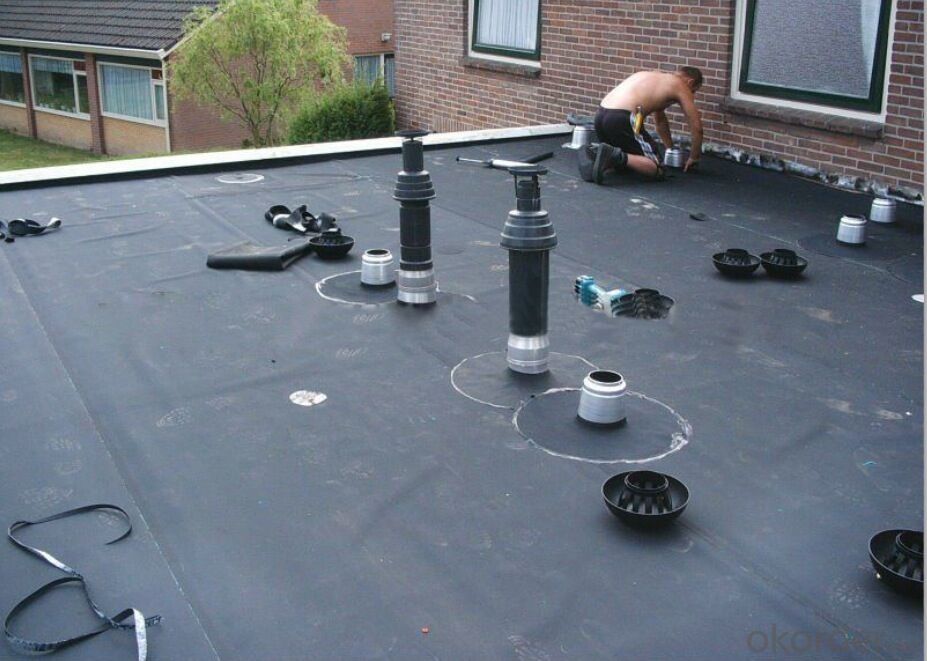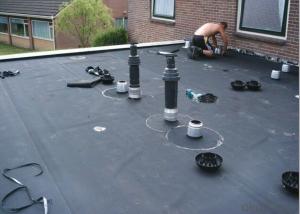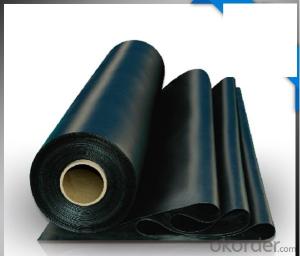EPDM Rubber Roofing Membrane 1.5 mm with Good Quality
- Loading Port:
- Tianjin
- Payment Terms:
- TT or LC
- Min Order Qty:
- 5000 m²
- Supply Capability:
- 100000 m²/month
OKorder Service Pledge
OKorder Financial Service
You Might Also Like
EPDM Rubber Roofing Membrane Applications:
1. Roofs, Basement, Toilets
2. Industrial and civil building waterproofing
3. Geosynthetic liner for swimming pool, channels, irrigation system
4. Especially suitable for projects with high requirements in durability, anti-corrosion and deformation.
EPDM Rubber Roofing Membrane Features:
1. Excellent physical and mechanical performance
2. High tearing resistance
3. Good deformation adaptability
4. High puncture resistance
5. High aging resistance
6. UV resistance
EPDM Rubber Roofing Membrane Advantages:
1. High elasticity among high polymer waterproof materialsand becomes a world-popular waterproofing material.
2. Adopts the world-advanced equipment of cold feeding extrusion and continuous vulcanization technology.
EPDM Rubber Roofing Membrane Specifications:
1. Material: EPDM Rubber
2. Size: 1.2m (width)*20m (length) or customized, weldable type 2.05m or 4m width
3. Thick: 1.2mm, 1.5mm, 2.0mm
4. Type: Vulcanized & Weldable
5. Pattern: Non-reinforced (homogeneous)
6. Certificate: ISO9001/14001
FAQ:
Q: Can I visit your company?
A: Yes, welcome to visit our enterprise.
Q: Can I do the third party testing before loading?
A: Yes, we could accept the third party testing.
Q: Which kind of payment in your company?
A: We could accept TT, LC at sight, etc.




- Q:Are waterproofing membranes resistant to earthquake movements?
- Waterproofing membranes serve the purpose of safeguarding structures, such as buildings and basements, from the invasion of water and moisture. While they effectively prevent water damage, they are not specifically engineered to withstand or endure the movements caused by earthquakes. Earthquakes involve the shaking and displacement of the ground, which exert considerable forces on structures. Waterproofing membranes do not typically possess the ability to absorb or distribute these forces in the same manner as seismic-resistant materials or building techniques. Nevertheless, it is important to note that certain waterproofing systems may exhibit a certain level of flexibility or elasticity, which could potentially offer some resistance against minor ground movements during an earthquake. These characteristics may assist in maintaining the integrity of the membrane and preventing water infiltration if slight shifting or settling occurs. Ultimately, when it comes to earthquake resistance, it is vital to employ specialized seismic design principles and techniques that are suitable for the specific location and building requirements. In order to ensure overall structural integrity and safety during seismic events, waterproofing membranes should be utilized in conjunction with these seismic-resistant measures.
- Q:Can a waterproofing membrane be used for HVAC systems?
- No, a waterproofing membrane cannot be directly used for HVAC systems. Waterproofing membranes are designed to prevent water from penetrating through surfaces such as roofs, foundations, or walls. They are typically made of materials like bitumen, rubber, or polyurethane and are meant to protect against water damage. On the other hand, HVAC (Heating, Ventilation, and Air Conditioning) systems are responsible for regulating temperature, humidity, and air quality within a building. They consist of various components like ductwork, air handlers, and condensing units that are specifically designed for the purpose of conditioning and circulating air. While there may be some overlap in terms of protecting certain HVAC system components from moisture, such as ductwork insulation, a waterproofing membrane alone is not sufficient or appropriate for HVAC systems. HVAC systems require specialized materials and equipment that are designed to handle the specific needs and requirements of air conditioning and ventilation. Therefore, it is important to use the proper materials and equipment specifically designed for HVAC systems to ensure their efficient and effective operation.
- Q:Can a waterproofing membrane be used for bridge decks?
- Yes, a waterproofing membrane can be used for bridge decks. Bridge decks are exposed to various weather conditions, including rain, snow, and humidity, which can cause damage and deterioration over time. Therefore, applying a waterproofing membrane on the bridge deck surface can help protect it from water infiltration and moisture-related issues such as corrosion of steel reinforcements. Waterproofing membranes are specifically designed to create a barrier that prevents water from penetrating the surface. They are typically made from materials such as modified bitumen, thermoplastic, or liquid-applied coatings. These membranes are applied to the bridge deck surface, creating a seamless and watertight layer that prevents water from seeping into the deck structure. In addition to preventing water infiltration, waterproofing membranes can also provide additional benefits for bridge decks. They can help reduce the risk of freeze-thaw damage, protect against chemical attacks from de-icing salts or pollutants, and increase the overall durability and lifespan of the bridge deck. It is important to note that the selection of the appropriate waterproofing membrane for a bridge deck depends on various factors such as the type of bridge, traffic conditions, climate, and expected service life. Therefore, it is essential to consult with structural engineers and waterproofing specialists to choose the most suitable membrane system for a specific bridge deck project.
- Q:Can a waterproofing membrane be used in conjunction with building code requirements?
- Yes, a waterproofing membrane can be used in conjunction with building code requirements. Building codes typically require that buildings have adequate moisture protection, especially in areas prone to water intrusion such as basements, bathrooms, and roofs. Waterproofing membranes are designed to create a barrier against water penetration, providing an additional layer of protection against moisture-related issues such as leaks, mold, and structural damage. By using a waterproofing membrane that meets or exceeds the requirements outlined in the building code, builders and contractors can ensure compliance with the code while also enhancing the durability and longevity of the structure.
- Q:What is waterproofing membrane?
- waterproofing membrane, high polymer modified asphalt waterproofing membrane and synthetic polymer waterproofing membrane; according to the different carcass are divided into no carcass membrane, paper coil, glass fiber Tire Coil, Glass Fabric Coil and Polyethylene Tire Coil.
- Q:Can a waterproofing membrane be used on concrete walls?
- Yes, a waterproofing membrane can be used on concrete walls. Waterproofing membranes are designed to provide a protective barrier against water penetration, and they can be applied to various surfaces including concrete walls. These membranes are typically made of materials such as modified bitumen, rubberized asphalt, or synthetic polymers, which are highly resistant to water and moisture. Applying a waterproofing membrane on concrete walls can effectively prevent water seepage, dampness, and potential damage caused by water infiltration. The membrane acts as a barrier, preventing water from permeating through the concrete and reaching the interior spaces. It also helps to maintain the structural integrity of the concrete by minimizing the risks of cracks, efflorescence, and other forms of moisture-related deterioration. There are different types of waterproofing membranes available in the market, such as sheet membranes, liquid membranes, and cementitious coatings. The choice of the membrane depends on factors such as the specific application, the degree of water exposure, and the condition of the concrete wall. It is essential to select a membrane that is compatible with the concrete and provides long-lasting waterproofing protection. Before applying the membrane, it is crucial to prepare the concrete surface properly. This may involve cleaning, repairing any cracks or imperfections, and ensuring that the surface is dry and free from any contaminants. The membrane is then installed according to the manufacturer's instructions, typically by adhering it to the concrete or by applying a liquid membrane using a brush or roller. In conclusion, a waterproofing membrane can be used on concrete walls to effectively protect them from water infiltration. This can help to maintain the durability and longevity of the concrete, as well as prevent potential water damage to the interior spaces. However, it is essential to choose the right type of membrane and follow proper installation procedures for optimal results.
- Q:Are waterproofing membranes suitable for residential applications?
- Indeed, residential applications can benefit greatly from the use of waterproofing membranes. These membranes find widespread use in a variety of residential construction areas, including basements, foundations, roofs, bathrooms, and balconies. Their primary purpose is to safeguard the building structure by preventing water penetration and moisture damage. Waterproofing membranes function as a barrier that effectively blocks water from infiltrating the structure, thereby averting problems such as mold growth, rot, or structural deterioration. These membranes commonly consist of materials such as bitumen, PVC, EPDM, or polyurethane, which possess exceptional water-repelling properties. During the construction or renovation process of residential buildings, waterproofing membranes are typically installed. They can be applied in the form of liquid coatings or sheets that are meticulously laid down and firmly affixed to the surface. These membranes create a seamless and long-lasting barrier that can withstand the test of time. Moreover, waterproofing membranes offer numerous advantages for residential applications. They help maintain a dry and comfortable living environment by preventing water leaks and dampness. As a result, they safeguard the integrity of the building materials, extend the lifespan of the structure, and minimize the likelihood of expensive repairs. Furthermore, these membranes contribute to enhanced energy efficiency by reducing heat loss or gain caused by moisture infiltration. By effectively blocking water, they assist in maintaining consistent temperatures inside the house, which leads to reduced energy consumption and lower utility bills. In conclusion, waterproofing membranes are an exceptional choice for residential applications. They provide dependable protection against water damage, enhance the longevity of the structure, and contribute to a healthier and more energy-efficient living environment.
- Q:Can a waterproofing membrane be used on fiberglass surfaces?
- Yes, a waterproofing membrane can be used on fiberglass surfaces.
- Q:Can waterproofing membranes be used on elevator pits?
- Yes, waterproofing membranes can be used on elevator pits. Elevator pits are prone to water infiltration, and using waterproofing membranes can help prevent water damage and corrosion in the pit area. The membranes create a barrier that prevents water from seeping into the pit, ensuring its dryness and structural integrity.
- Q:Can a waterproofing membrane be used in temporary or temporary structures?
- Indeed, temporary or transient structures can benefit from the utilization of a waterproofing membrane. These specialized membranes are crafted to establish a safeguard against the infiltration of water, a critical measure in thwarting any potential moisture-related harm in various architectural formations. Be it a fixed or impermanent construction, such as a provisional refuge, tent, or temporary worksite, the application of a waterproofing membrane guarantees the attainment of water resistance and protection. Consequently, it becomes imperative to meticulously select a waterproofing membrane that aligns with the distinct requisites of the temporary structure, while adhering to the appropriate installation protocols to ensure its utmost efficacy.
1. Manufacturer Overview |
|
|---|---|
| Location | |
| Year Established | |
| Annual Output Value | |
| Main Markets | |
| Company Certifications | |
2. Manufacturer Certificates |
|
|---|---|
| a) Certification Name | |
| Range | |
| Reference | |
| Validity Period | |
3. Manufacturer Capability |
|
|---|---|
| a)Trade Capacity | |
| Nearest Port | |
| Export Percentage | |
| No.of Employees in Trade Department | |
| Language Spoken: | |
| b)Factory Information | |
| Factory Size: | |
| No. of Production Lines | |
| Contract Manufacturing | |
| Product Price Range | |
Send your message to us
EPDM Rubber Roofing Membrane 1.5 mm with Good Quality
- Loading Port:
- Tianjin
- Payment Terms:
- TT or LC
- Min Order Qty:
- 5000 m²
- Supply Capability:
- 100000 m²/month
OKorder Service Pledge
OKorder Financial Service
Similar products
New products
Hot products
Related keywords




























